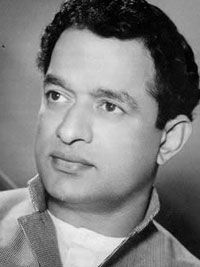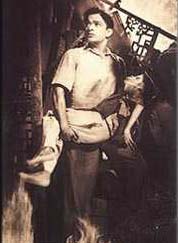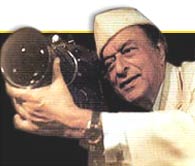arpita
Prime VIP
V Shantaram

V Shantram was one of the founding fathers of Indian cinema. His art and works remain unparalleled in aesthetics and technique to this day. True to the name of the company ‘Prabhat’ that he founded; V. Shantram was not just a pioneering actor, director and producer of the Bollywood, but a genius who infused talent, creativity and life into the fledgling industry. An indefatigable worker to his last days V. Shanataram left an extensive body of his works for others to seek inspiration and emulate.
As is true of most of the showbiz greats of yesteryears, this doyen was born in a household of very modest means as Rajaram Vankudre Shantaram in 1901 at Kolhapur. Due to urgencies of being born in a poor house, V. Shantram was deprived of his basic education. He started working early in life on small time jobs to support himself and his family. Mysterious indeed are the ways of destiny! One of the greatest showmen of Bollywood was to begin his career as a curtain puller in a theatre. V. Shantaram kept on doing such lowly jobs, while picking up nuances of acting and filmmaking in whatever interaction he had with professionals of those times.
Slowly, he graduated to acting and performed a role in Savkari Pash (1925) directed by Babu Ram Painter. In the process he became one of the ardent disciples of Painter, A stroke of fate brought Shantram in contact with V.G. Damle, K.R. Dhaiber, Syed Fatelal, and S.B. Kulkarni – all professionals in different aspects of filmmaking. In 1929 they set up the Prabhat Film Company. Prabhat came out with a brilliant movie Gopal Krishna (1931). Those were the times when mythological themes generated greater interest than social ones. But it was the ingenuity of Shantram and his colleagues that they could bring about fusion of contemporary themes into mythological dramas. ‘Ayodhya Ka Raja (1932) was the first talking picture produced by Prabhat.
 As the silent movies gave way to ‘talkies’, the glory of Painter was on the wane and the star of his protégés came on the ascendant. After making a few hits, Shantaram became obsessed with the idea of making a colour motion picture. This experimentation sent him to a tour of Germany, where he met some of the best cinematographers of that age. V.Shantaram fully incorporated the ‘tricks of the trade’ learnt in Europe and imbibed them in his craft. Since then there was no looking back for V. Shantram as he churned out film-by-film; winning public acclaim and awards on regular intervals.
As the silent movies gave way to ‘talkies’, the glory of Painter was on the wane and the star of his protégés came on the ascendant. After making a few hits, Shantaram became obsessed with the idea of making a colour motion picture. This experimentation sent him to a tour of Germany, where he met some of the best cinematographers of that age. V.Shantaram fully incorporated the ‘tricks of the trade’ learnt in Europe and imbibed them in his craft. Since then there was no looking back for V. Shantram as he churned out film-by-film; winning public acclaim and awards on regular intervals.
This was also the time he shifted to Poona and set up his studio on a sprawling piece of land. V.Shantaram produced and directed ‘Amrit Manthan’ set in the ancient society when Buddhism had challenged the decadent ritualistic practices. The film subtly tried to comment on the life and times of current society too. In Padosi (1941) V Shantram seemed to make a desperate appeal to his people to forsake sectarianism and bigotry.
A quirk of fate made him dismantle the Parbhat Film Company in 1942 and he set up his own production unit under the banner of RajKamal Mandir in Bombay. It is here that some of the best-directed films of V.Shantram like Dr. Kotnis Ki Amar Kahani (1942) and Do Aakhen Baara Haath (1957) saw the light of the day. Do Aakhen Baara Haath (1957) won many National and International Awards, including the Silver Bear at the Berlin Film Festival and the Samuel Goldwyn Award for Best Foreign Film. Besides, the film won the President's Gold Medal as the Best Feature of 1957 in India.
 Dahej (1950) was a poignant commentary on the evil of dowry. We see strong under currents of social reform in most of the films produced and directed by V. Shantaram. The first colour film of V. Shantaram Jhanak Jhanak Payal Baaje (1955) was a box office hit. As the time progressed he launched his daughter Rajshree in Geet Gaya Pathron Nein (1960). Pinjra (1972), a bi-lingual in Hindi and Marathi stands out as a trademark V. Shantaram film in many of his later works. However, the last film Jhanjaar (1986) performed miserably.
Dahej (1950) was a poignant commentary on the evil of dowry. We see strong under currents of social reform in most of the films produced and directed by V. Shantaram. The first colour film of V. Shantaram Jhanak Jhanak Payal Baaje (1955) was a box office hit. As the time progressed he launched his daughter Rajshree in Geet Gaya Pathron Nein (1960). Pinjra (1972), a bi-lingual in Hindi and Marathi stands out as a trademark V. Shantaram film in many of his later works. However, the last film Jhanjaar (1986) performed miserably.
V.Shantram passed away in 1990 at the ripe old age of 89. A versatile genius, the life flow of V.Shantram was marked exactly by the time and tenure of the emergence and evolution of Indian cinema. V. Shantaram had seen and performed in all the eras of the Indian film. But as someone has said, “Life is short and art is long”-- the ever-onward journey of filmmaking continues to prosper, as the memories of this great master slowly faint into obscurity.

V Shantram was one of the founding fathers of Indian cinema. His art and works remain unparalleled in aesthetics and technique to this day. True to the name of the company ‘Prabhat’ that he founded; V. Shantram was not just a pioneering actor, director and producer of the Bollywood, but a genius who infused talent, creativity and life into the fledgling industry. An indefatigable worker to his last days V. Shanataram left an extensive body of his works for others to seek inspiration and emulate.
As is true of most of the showbiz greats of yesteryears, this doyen was born in a household of very modest means as Rajaram Vankudre Shantaram in 1901 at Kolhapur. Due to urgencies of being born in a poor house, V. Shantram was deprived of his basic education. He started working early in life on small time jobs to support himself and his family. Mysterious indeed are the ways of destiny! One of the greatest showmen of Bollywood was to begin his career as a curtain puller in a theatre. V. Shantaram kept on doing such lowly jobs, while picking up nuances of acting and filmmaking in whatever interaction he had with professionals of those times.
Slowly, he graduated to acting and performed a role in Savkari Pash (1925) directed by Babu Ram Painter. In the process he became one of the ardent disciples of Painter, A stroke of fate brought Shantram in contact with V.G. Damle, K.R. Dhaiber, Syed Fatelal, and S.B. Kulkarni – all professionals in different aspects of filmmaking. In 1929 they set up the Prabhat Film Company. Prabhat came out with a brilliant movie Gopal Krishna (1931). Those were the times when mythological themes generated greater interest than social ones. But it was the ingenuity of Shantram and his colleagues that they could bring about fusion of contemporary themes into mythological dramas. ‘Ayodhya Ka Raja (1932) was the first talking picture produced by Prabhat.

This was also the time he shifted to Poona and set up his studio on a sprawling piece of land. V.Shantaram produced and directed ‘Amrit Manthan’ set in the ancient society when Buddhism had challenged the decadent ritualistic practices. The film subtly tried to comment on the life and times of current society too. In Padosi (1941) V Shantram seemed to make a desperate appeal to his people to forsake sectarianism and bigotry.
A quirk of fate made him dismantle the Parbhat Film Company in 1942 and he set up his own production unit under the banner of RajKamal Mandir in Bombay. It is here that some of the best-directed films of V.Shantram like Dr. Kotnis Ki Amar Kahani (1942) and Do Aakhen Baara Haath (1957) saw the light of the day. Do Aakhen Baara Haath (1957) won many National and International Awards, including the Silver Bear at the Berlin Film Festival and the Samuel Goldwyn Award for Best Foreign Film. Besides, the film won the President's Gold Medal as the Best Feature of 1957 in India.

V.Shantram passed away in 1990 at the ripe old age of 89. A versatile genius, the life flow of V.Shantram was marked exactly by the time and tenure of the emergence and evolution of Indian cinema. V. Shantaram had seen and performed in all the eras of the Indian film. But as someone has said, “Life is short and art is long”-- the ever-onward journey of filmmaking continues to prosper, as the memories of this great master slowly faint into obscurity.
